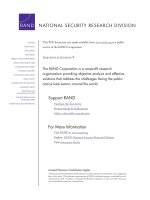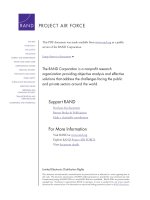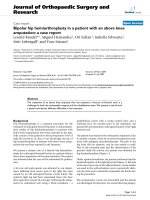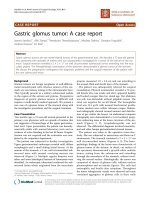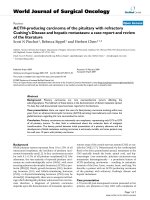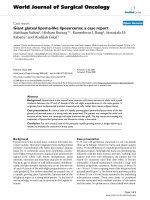Meeting America’s Security Challenges Beyond Iraq - A Conference Report pptx
Bạn đang xem bản rút gọn của tài liệu. Xem và tải ngay bản đầy đủ của tài liệu tại đây (278.29 KB, 43 trang )
This document and trademark(s) contained herein are protected by law as indicated in a notice appearing later in
this work. This electronic representation of RAND intellectual property is provided for non-commercial use only.
Unauthorized posting of RAND PDFs to a non-RAND Web site is prohibited. RAND PDFs are protected under
copyright law. Permission is required from RAND to reproduce, or reuse in another form, any of our research
documents for commercial use. For information on reprint and linking permissions, please see RAND Permissions.
Limited Electronic Distribution Rights
This PDF document was made available from www.rand.org as a public
service of the RAND Corporation.
6
Jump down to document
THE ARTS
CHILD POLICY
CIVIL JUSTICE
EDUCATION
ENERGY AND ENVIRONMENT
HEALTH AND HEALTH CARE
INTERNATIONAL AFFAIRS
NATIONAL SECURITY
POPULATION AND AGING
PUBLIC SAFETY
SCIENCE AND TECHNOLOGY
SUBSTANCE ABUSE
TERRORISM AND
HOMELAND SECURITY
TRANSPORTATION AND
INFRASTRUCTURE
WORKFORCE AND WORKPLACE
The RAND Corporation is a nonprofit research
organization providing objective analysis and effective
solutions that address the challenges facing the public
and private sectors around the world.
Visit RAND at www.rand.org
Explore RAND Project AIR FORCE
View document details
For More Information
Purchase this document
Browse Books & Publications
Make a charitable contribution
Support RAND
This product is part of the RAND Corporation conference proceedings series. RAND
conference proceedings present a collection of papers delivered at a conference. The
papers herein have been commented on by the conference attendees and both the in-
troduction and collection itself have been reviewed and approved by RAND Science
and Technology.
PROJECT AIR FORCE
Meeting America’s
Security Challenges
Beyond Iraq
A Conference Report
Sarah Harting
Prepared for the United States Air Force
Approved for public release; distribution unlimited
The RAND Corporation is a nonprofit research organization providing objective analysis
and effective solutions that address the challenges facing the public and private sectors
around the world. RAND’s publications do not necessarily reflect the opinions of its
research clients and sponsors.
R
®
is a registered trademark.
© Copyright 2008 RAND Corporation
All rights reserved. No part of this book may be reproduced in any form by any electronic or
mechanical means (including photocopying, recording, or information storage and retrieval)
without permission in writing from RAND.
Published 2008 by the RAND Corporation
1776 Main Street, P.O. Box 2138, Santa Monica, CA 90407-2138
1200 South Hayes Street, Arlington, VA 22202-5050
4570 Fifth Avenue, Suite 600, Pittsburgh, PA 15213-2665
RAND URL:
To order RAND documents or to obtain additional information, contact
Distribution Services: Telephone: (310) 451-7002;
Fax: (310) 451-6915; Email:
Publication of this report was sponsored by the United States Air Force under Contract
FA7014-06-C-0001. Further information may be obtained from the Strategic Planning
Division, Directorate of Plans, Hq USAF.
Library of Congress Cataloging-in-Publication Data
Harting, Sarah.
Meeting America’s security challenges beyond Iraq : a conference report / Sarah Harting.
p. cm.
Includes bibliographical references.
ISBN 978-0-8330-4469-3 (pbk. : alk. paper)
1. National security—United States—21st century—Congresses. 2. United States—Military policy—21st
century—Congresses. 3. United States—Armed Forces—Organization—Congresses. 4. United States. Dept.
of Defense—Appropriations and expenditures—Congresses. I. Title.
UA23.H3668 2008
355'.033073—dc22
2008028846
iii
Preface
On December 4, 2007, the RAND Corporation and the Center for Naval Analyses (CNA)
cohosted a conference entitled, “Meeting America’s Security Challenges Beyond Iraq.” e
conference, which included approximately 70 senior analysts from selected think tanks and
academic institutions, high-ranking officers from the military services, selected government
officials, and several journalists, was held at the offices of the RAND Corporation in Arling-
ton, Virginia. e purpose of this conference was to provide leading analysts and practitioners
of U.S. security policy and strategy with an opportunity to assess key challenges in the emerg-
ing security environment and to consider implications for strategy, force posture, and invest-
ment priorities.
is conference report provides an overview of the major topics, themes, and issues
addressed at the conference as interpreted by RAND and CNA staff. To encourage a candid
discussion of issues, the conference was held on a “not for attribution” basis; hence, the identi-
ties of the presenters and discussants are not provided.
RAND Project AIR FORCE
RAND Project AIR FORCE (PAF), a division of the RAND Corporation, is the U.S. Air
Force’s federally funded research and development center for studies and analyses. PAF pro-
vides the Air Force with independent analyses of policy alternatives affecting the development,
employment, combat readiness, and support of current and future aerospace forces. Research is
conducted in four programs: Aerospace Force Development; Manpower, Personnel, and Train-
ing; Resource Management; and Strategy and Doctrine. Additional information about PAF is
available on our Web site:
/>Center for Naval Analyses
e Center for Naval Analyses, a division of CNA, is the U.S. Navy’s federally funded research
and development center for studies and analyses. e Center for Naval Analyses provides sup-
port to the Navy and Marines across the spectrum of defense activities, from personnel to tech-
nology, to operations and readiness. It does this by working directly with operating forces, as
well as Navy, Marine Corps, and joint commands, in war and in peace. For over 60 years, since
their groundbreaking work with the Navy during World War II, CNA’s goal has been to use
iv Meeting America’s Security Challenges Beyond Iraq
scientific techniques to support the effective use of naval forces—and other defense concerns.
Additional information about CNA is available at
v
Contents
Preface iii
Summary
vii
Acknowledgments
xi
Abbreviations
xiii
Introduction and Overview
1
SESSION I
Overview of the Emerging Security Environment 3
Five Trends Affecting U.S. Security
3
“Five Long Wars”: America’s Security Landscape Beyond Iraq
4
reads of Instability
5
Question and Answer Session
5
SESSION II
Key reats and Challenges for the Future 7
China as a Strategic Challenge
7
Nuclear-Armed Regional Adversaries
8
Question and Answer Session—Part 1
9
Terrorism and Insurgency: e Changing reat
9
Question and Answer Session—Part 2
10
Iran: A Multidimensional Challenge
10
Question and Answer Session—Part 3
11
Midday Presentation
13
Question and Answer Session
14
SESSION III
Priority Capabilities for Securing U.S. Interests 15
Achieving Global Effects
15
Defeating “Hybrid reats” in the 21st Century
15
Capabilities Required for Countering State Adversaries
16
Understanding Possibilities and Risks
16
Question and Answer Session
17
vi Meeting America’s Security Challenges Beyond Iraq
SESSION IV
Fielding the Requisite Forces in a Resource-Constrained Environment 19
Federal Budget Trends and the Outlook for Defense Programs
19
A New Division of Labor Among America’s Armed Forces
20
U.S. Ground Forces: Options for Future Development
20
Question and Answer Session
21
Closing Remarks
23
Question and Answer Session
24
Conference Agenda
25
Bibliography
27
vii
Summary
On December 4, 2007, RAND Project AIR FORCE and the Center for Naval Analyses hosted
a conference, “Meeting America’s Security Challenges Beyond Iraq.” From the outset, it was
clear that the phrase “beyond Iraq” does not mean that supporting the emergence of a stable
Iraq will soon disappear as a major security issue for the United States. On the contrary, all
participants recognized that the wars in Iraq and Afghanistan are likely to persist well into
the future. e security obligations associated with these conflicts would join the list of ongo-
ing security obligations the United States must already address, such as countering terrorists,
deterring Iran and keeping open the Straits of Hormuz, promoting peace on the Korean pen-
insula and across the Taiwan Strait, and strengthening alliances more generally.
ere was broad consensus throughout the discussion that the following are among the
issues and challenges to U.S. foreign and security policy that any new administration will have
to face:
e United States needs to restore its credibility as a world leader in the face of wide-1.
spread anti-American sentiments. Regaining an influential voice in regional security
matters was also considered necessary for protecting and advancing U.S. and allied
interests. (See pp. 3–5.)
e executive branch needs to greatly improve the integration of interagency approaches 2.
to complex security problems. is is particularly urgent because the problems that arise
when combining traditional and irregular warfare, as in Iraq and Afghanistan, have
historically persisted for many years and will likely continue in the indefinite future.
(See pp. 4–6.)
Dealing with the emergence of China in all its many manifestations is going to be a 3.
multigenerational issue for the United States. In the security field, it will be important
that, as China improves its military capabilities, the United States maintain key advan-
tages or risk losing its credibility as a guarantor of stability in East Asia. (See pp. 3–4.)
U.S. defense planners need to prepare to counter nuclear-armed regional adversaries in 4.
case nonmilitary activities fail to prevent the proliferation of nuclear weapons. Aside
from the longstanding concern about the possibility of proliferation to terrorists, the
reality of nuclear-armed “rogue regimes,” such as North Korea and, potentially, Iran,
could profoundly alter regional security environments in ways that would be extraordi-
narily harmful to U.S. interests. (See p. 4.)
e nexus of rapid population growth in the Islamic world, stalled economic growth, 5.
and vehement anti-Americanism suggests that the “long war” will indeed be long. e
viii Meeting America’s Security Challenges Beyond Iraq
so-called youth bulge creates huge potential recruitment pools for jihadist extremists.
(See pp. 3–4.)
While these concerns reflect a broad consensus among the conferees, there was less agree-
ment about how to respond. If the United States is to meet these challenges, along with exist-
ing security obligations, its armed forces will be called upon to undertake a range of “nontradi-
tional” missions at a scale and level of intensity well beyond what today’s forces can sustain.
In turn, conferees discussed whether the notion of complex or “hybrid” wars helps plan-
ners prepare for future conflicts. Some conferees linked the idea of hybrid wars with “regime
change” operations and were convinced the Iraq experience has made it very unlikely that
there will be any appetite in Washington for such endeavors in the future. Others argued that,
given a long history of U.S. military action against regimes (going back to the Mexican War),
it would be wrong to discount the possibility of future similar operations.
In addition, there was considerable discussion among conferees about whether U.S.
ground forces need to be restructured or realigned to better conduct counterinsurgency, foreign
internal defense, and constabulary missions. e debate revolved around competing visions of
the future. On one hand, if Iraq and Afghanistan are going to be the final U.S. experience
with counterinsurgency, restructuring forces might be unnecessary. On the other hand, if
the United States is destined to be engaged in conflicts that include both traditional combat
and counterinsurgency operations, some form of restructuring is merited. Several participants
observed that the currently planned expansion of ground forces makes it easier to contemplate
realignment.
Most conferees agreed that the Navy and Air Force should focus on major combat opera-
tions against regional powers to maintain the ability to employ overwhelming airpower with
precision weapons from land bases and from the sea in more than one region of the world. Some
saw this capability as an important “strategic hedge.” By the same token, the contributions
both services are providing to ongoing conflicts in Iraq and Afghanistan are ample illustration
that the capabilities they bring to the fight are applicable across a wide array of circumstances
today and will be into the future.
In short, there was widespread agreement that the set of the challenges the United States
faces, coupled with the varied demands on the military forces, will require significant changes
in how the Department of Defense trains, equips, and postures its forces and, more broadly,
how the U.S. government is organized for the advancement of U.S. interests abroad. Promi-
nent examples of such changes include the following:
U.S. forces will need to be able to conduct, on a sustained basis, a large number of “train-t
equip-advise-assist” missions in countries striving to counter Islamist-based terrorist and
insurgent movements. Substantial numbers of U.S. ground forces will be associated with
this mission. (See pp. 15–16, 20–21.)
Nonmilitary agencies, including the Department of State, the U.S. Agency for Interna-t
tional Development, the Department of Justice, and the Intelligence Community, must
play more visible and, ultimately, predominant roles in efforts to counter terrorist and
insurgent groups abroad. (See pp. 9–10, 21, 23–24.)
U.S. and allied forces will need to prepare for the possibility that regional adversaries, such t
as North Korea and Iran, may soon field nuclear weapons. is will raise a host of large,
crosscutting policy issues (such as whether the goal of regime change through invasion
Summary ix
and occupation is still appropriate and feasible in the presence of a nuclear threat). It will
also call attention to important capability shortfalls (such as the inability to locate and
destroy nuclear weapons and their delivery means, as well as the ability to deploy effec-
tive, multilayered defenses against a missile attack with nuclear weapons). (See pp. 8–9,
13–14.)
As China continues to modernize its conventional forces, U.S. planners will be compelled t
to rethink key aspects of the U.S. approach to power projection, as the U.S. posture in
the Western Pacific is becoming increasingly vulnerable to Chinese antiaccess weapons.
(See pp. 7–8, 16.)
Furthermore, while there was agreement that the interagency process sometimes borders
on dysfunctional, there was little agreement on how to correct the problem. e next adminis-
tration will have to determine, systematically and thoughtfully, how to address the budgetary,
cultural, and planning differences among the departments of Defense, State, Treasury, and
Agriculture and other parts of the government. It will also need to focus on timely implemen-
tation of policy. Today, it is almost impossible to reach agreement on how to define problems
and identify solutions. And few agencies other than the Department of Defense have the capa-
bilities necessary to conduct large-scale operations in austere environments—a growing need
in many places.
Finally, pressures on defense spending within the overall U.S. budget cast a long shadow.
e combination of existing requirements, including Iraq and Afghanistan, with future chal-
lenges suggests that the demand for defense resources will increase rather than decrease even as
these conflicts subside. e ground forces need to recapitalize, as do the Air Force and Navy,
as the inventories of frontline aircraft and ships reach and often exceed their expected service
lives. No one expected defense budgets to remain at current levels, much less increase. All,
however, acknowledged that difficult choices loom in the not too distant future.
xi
Acknowledgments
We would like to thank several individuals at both RAND and CNA who provided key
guidance and assistance throughout the preparation of this report. We extend our thanks
to Andrew Hoehn, David Ochmanek, and Michael Spirtas at RAND; and Christine Fox,
Michael McDevitt, and Daniel Whiteneck at CNA.
We also thank our project sponsors in the U.S. Air Force and the U.S. Navy. In particu-
lar, we acknowledge Maj Gen William Chambers, David Moniz, and Christy Nolta in the
U.S. Air Force, in addition to the Naval Operations staff, for their support of this endeavor.
In addition, we are grateful to a number of RAND and CNA staff who helped to make
this conference possible. In particular, Kathy Berens and Kathy Lewis at CNA; and Molly
Coleman, Emily Taylor, Nathan Chandler, Leslie ornton, Emily Daly, Katherine Mills,
Matthew Lolich, and Leanna Ferguson at RAND.
Finally, we extend our sincere thanks to all our conference participants for their time and
their willingness to express their views on these important policy issues.
xiii
Abbreviations
CNA Center for Naval Analyses
DoD Department of Defense
GDP gross domestic product
MCO major combat operation
PAF Project AIR FORCE
PLA People’s Liberation Army
WMD weapons of mass destruction
1
Introduction and Overview
e “Meeting America’s Security Challenges Beyond Iraq” conference was organized into four
main sessions:
Overview of the Emerging Security Environmentt
Key reats and Challenges for the Futuret
Priority Capabilities for Securing U.S. Interestst
Fielding the Requisite Forces in a Resource-Constrained Environment.t
Each session featured several short presentations presided over by a panel moderator. Fol-
lowing these, conference participants offered questions and reactions to the presentations. (See
Appendix A for the conference agenda.)
Following Sessions II and IV, a senior military officer provided remarks and participated
in a question and answer session. e sections that follow provide brief summaries of all of
the presentations along with the salient points of the ensuing discussions. To facilitate a frank
and open exchange of ideas, the conference was conducted under Chatham House rules of
nonattribution.
3
SESSION I
Overview of the Emerging Security Environment
How should the United States deal with trends? Shape them? Cope with them?
—Senior Military Analyst
e panel members in this session took a broad view of the defense challenges that the United
States is likely to face over the next ten years and likely beyond. ey also discussed a number
of trends and long-term issues that will require the continued attention of U.S. military
planners.
Five Trends Affecting U.S. Security
e first presentation made it clear that the phrase “beyond Iraq” should not be construed as
suggesting that supporting the emergence of a stable Iraq will disappear as a major security
issue for the United States any time soon. On the contrary, the presentation noted that the
wars in Iraq and Afghanistan are likely to persist well into the future. e presenter argued that
the security obligations associated with these conflicts would join the list of ongoing security
obligations the United States must already address, such as countering terrorists, deterring Iran
and keeping open the Straits of Hormuz, promoting peace on the Korean peninsula and across
the Taiwan Strait, and strengthening alliances. ese should be considered givens for thinking
about the future.
In light of these obligations, the panelist focused on five trends that will affect the U.S.
security environment. e first is the erosion of U.S. influence. is includes the perceived
decline in U.S. power and credibility, which weakens U.S. efforts to deter adversaries, reassure
allies, and shape regional security environments. e second is the rise of China as a global
military and economic power, its capacity to translate that power into a coherent political and
strategic challenge, and the widespread effects that China will have on the regional balance
in Asia, which could negatively affect America’s position as a guarantor of stability on the lit-
toral of East Asia. e third trend was changes in demographics (and their likely effects on
politics and security concerns in Europe, Russia, the Middle East, and Africa). Of particular
concern is the so-called youth bulge in much of the Muslim world. e combination of a
pervasive anti-American sentiment in many Muslim countries and a huge pool of potential
jihadi recruits suggests that the “long war” will indeed be long. e fourth trend is the role
of some energy-producing states (e.g., Russia, Iran, and Venezuela), which are being enriched
by a cost of oil near US$100 per barrel and, as a result, will have the resources to pursue poli-
cies inimical to U.S. interests. is trend reflects the intersection of national security, energy
4 Meeting America’s Security Challenges Beyond Iraq
economics, domestic politics, and the need for integrated solutions across government agencies
and between the U.S. and its allies. e final trend discussed was the proliferation of nuclear
weapons and related technologies. e concerns here are preventing the spread of such capabil-
ities to nonstate adversaries, strengthening U.S. leadership of multilateral counterproliferation
efforts, and reinforcing U.S. deterrence credibility. Of specific interest to long-range planners
in the Department of Defense (DoD), the panelist concluded by outlining the potential stra-
tegic consequences of certain tactical military developments, such as antiship ballistic missiles
and the global use of improvised explosive devices.
“Five Long Wars”: America’s Security Landscape Beyond Iraq
e second presentation provided a somewhat different perspective on five strategic challenges
that the presenter argued will dominate America’s future security landscape: radical Islam,
China’s growing power and security competition in Asia, regional powers with nuclear weap-
ons, Russia’s problematic resurgence, and shifting alliance and partner relationships.
e speaker asserted that radical Islam and the terrorist groups that it spawns will remain
a challenge for many years to come. Successfully combating this challenge will require a shift
from the approach the administration has taken since 2001. Specifically, instead of “tradi-
tional” warfighting capabilities, U.S. forces and other assets will need to conduct a sustained
and sizeable effort to train, equip, advise, and assist host-nation forces to counter nonstate
adversaries.
Secondly, the panelist discussed how China’s growth fuels a strategic competition between
Beijing and Washington that could be increasingly difficult to manage. is challenge is com-
pounded by the fact that both Japan and India are emerging as well, although in different
ways. erefore, the United States will need to strengthen regional partnerships in the face of
these challenges.
e panelist defined the third challenge—regional powers with nuclear weapons—in
terms of a “weak” state seeking nuclear weapons as a deterrent against attack. It will be difficult
for the United States to prevent such states from obtaining nuclear weapons and from consid-
ering using them in the event of a future conflict. Deterring regional nuclear powers during
crises will be considerably different from deterring Russia and China. Meeting this challenge
will require substantially improved active defenses and, perhaps, new approaches for power-
projection operations. (See “Nuclear-Armed Regional Adversaries” in Session II.)
e fourth challenge, Russia’s resurgence, arises from Russian economic growth coupled
with the reestablishment of authoritarian governance and Moscow’s willingness to assert itself
in opposition to U.S. interests. ese developments will likely continue and will require sus-
tained attention from the United States.
Finally, the panelist focused on shifting alliances and partnerships, arguing that relations
between the United States and its security partners are changing and deteriorating in many
areas, partially because perceptions about the risks and rewards associated with being allied
with the United States have been changing. ese shifting relationships are fostering a new
“strategic geometry” of sorts, as allies and partners recalculate costs and benefits.
In light of these challenges, the panelist noted that defense planning in the United States
is becoming far more complex. While the capabilities for prevailing in major combat opera-
tions (MCOs) will still be essential, the nature of these conflicts is changing. At the same time,
Overview of the Emerging Security Environment 5
capabilities will be needed for other sorts of operations that are not “lesser included cases” of
the MCO. Hence, resources and forces may not be fungible across this set of challenges. As a
result, the speaker argued that the DoD must obtain and sustain awareness of these challenges,
reconcile U.S. ends and means with those of its partners, and establish a new division of labor
among the services to shape the unfolding challenges. (For more on this, see “A New Division
of Labor Among America’s Armed Forces” in Session IV.)
Threads of Instability
In response to the two presentations above, one panelist added that demographic trends; eco-
nomic trends, such as globalization; competition for resources, such as petroleum; and climate
change are testing the capacities of a number of states, increasing the potential for state failure.
is, in turn, warrants greater concern for ungoverned territories. e panelist argued that all
this is complicated by the fact that a number of traditional U.S. allies are facing demographic
and fiscal challenges. Furthermore, these challenges necessitate an indirect approach, with the
United States putting its emphasis on building partner capacity, and its allies putting theirs on
strengthening internal sovereignty and tailoring their forces to be capable of working with the
United States to address nontraditional threats.
e panelist then continued with a discussion of several specific challenges:
“hybrid” forms of warfaret
1
the use of weapons of mass destruction (WMD) outside the MCO context (e.g., threat t
reduction and consequence management)
the potential collapse of a major allyt
the threat of a humanitarian disaster on a catastrophic scale.t
e panelist argued that the United States needs to work on restoring its global influence
and leadership position, because allies will continue to demand U.S. leadership on and engage-
ment in traditional concerns and involvement in emerging areas of instability, from Africa to
the Caucasus to Asia. e panelist added that addressing these challenges will require a high
degree of U.S. engagement over sustained periods. e panelist also noted that many past
planning assumptions are no longer valid and that the United States will need joint military
teams to address different types of conflicts.
Question and Answer Session
e first comment focused on public opinion and, more specifically, on what can be done to
foster positive perceptions of the United States internationally. e commentator mentioned
the success of the model that was used during the Cold War and asked whether it would be
1
In defining hybrid challenges, the panelist described them as overlapping those found in the 2006 Quadrennial Defense
Review: irregular, disruptive, catastrophic, and traditional challenges. See U.S. Department of Defense, Quadrennial
Defense Review Report, Washington, D.C., February 6, 2006, p. 19.
6 Meeting America’s Security Challenges Beyond Iraq
prudent to replicate such a model today. is participant argued that changing public opinion
is not cheap, but lessons can be taken from past efforts.
Another participant said that efforts to address demographic and social trends of concern
should focus on enhancing civil society in Islamic states.
Another attendee questioned how U.S. policies can target the underlying causes of some
emerging challenges more effectively. Several panelists agreed that more needed to be done
along these lines. For example, how can the United States marginalize support for extremists?
How can the United States help reform corrupt political regimes? All these questions taken
together formed a first impression of a key conference theme: the need for the U.S. government
and DoD to pay attention to integrated interagency approaches to complex future security
issues and the need to address the budgetary, cultural, and planning differences between the
departments of Defense, State, Treasury, and Agriculture and other parts of the government in
defining problems and identifying potential solutions.
A final question centered on the direction of the United States itself, both internally and
externally. A conference attendee asked the panelists about the current U.S. federal budget
deficit and what the United States should do to make itself more financially solvent. One pan-
elist responded by stating that meeting the challenges of the emerging security environment
will require the United States to maintain a level of military spending somewhat higher (in
terms of percentage of gross domestic product [GDP]) than what it had spent in the immediate
aftermath of the Cold War.
7
SESSION II
Key Threats and Challenges for the Future
Deterrence alone is not a fully satisfactory answer to nuclear-armed regional adversaries.
—Senior Defense Analyst
Victory over terrorists and insurgents will come not from ‘capture and kill’ operations, but
by breaking the cycle of radicalization, recruitment, and training. . . . We need to focus on
ways to shape the perceptions and options of those who are children today in the Islamic
world.
—Senior Defense Analyst
While the first panel took a global view of emerging security challenges, the second focused on
a few distinct threats and challenges. Specifically, panel members focused on four main topics:
China, nuclear-armed regional adversaries, terrorism and insurgency, and Iran.
China as a Strategic Challenge
e first speaker discussed key dimensions of the strategic challenges China poses. e speaker
argued that China’s reemergence is one of the most significant political developments of our
time. China is in the midst of a drive to modernize its military forces. e panelist noted that
the country can now shape the environment rather than just react to it. Two factors of particu-
lar note in China’s reemergence are the speed at which this is taking place and how globaliza-
tion is supporting the growth of the nation’s economy and the spread of its influence.
e panelist argued that China’s rise poses several challenges to international order, spe-
cifically with regard to economic and military issues. China’s military and economic mod-
ernization is accompanied by political and diplomatic confidence exercised in regional and
global forums ranging from the Six-Party Talks to the Shanghai Cooperation Organization
and the United Nations. China’s reemergence poses a number of unknowns: how China will
use its economic clout; the abilities, agendas, and relationships among civilian elites in China;
and whether the Communist Party will be able to transform itself to address its own range of
domestic issues and concerns.
Next, the panelist questioned how the United States and its allies (e.g., the European
Union, South Korea, Japan, and Australia) will react to a resurgent China. e panelist argued
that concerns about the capabilities and institutional prerogatives of the People’s Liberation
Army (PLA) are warranted. e United States can assess the modernization of the PLA’s forces
8 Meeting America’s Security Challenges Beyond Iraq
with some confidence. is modernization effort is broad-based and ambitious and will pro-
foundly affect the military balance in East Asia. For example, the PLA, long a ground-centric
force, has now transformed into more of a naval- and air-centric force capable of protect-
ing interests at home and abroad. e Chinese are applying both capabilities-based and con-
tingency-based planning constructs. e panelist explained that, since the early 1990s, PLA
efforts have focused on preparing for local wars. Recently, the PLA has shifted its attention
to preparing for short but decisive conflicts and operations that depend heavily on command,
control, communications, computers, intelligence, surveillance, and reconnaissance. It is also
developing capabilities to deny U.S. forces access to the region. e panelist posited that U.S.
forces will have to transform and modernize to “rise on the same tide” as the Chinese.
Turning to Chinese domestic issues, the panelist emphasized the increasing demographic
bulge that is fostering a cadre of disenfranchised and potentially angry youth in China and
noted that this bulge could have implications for China’s internal stability. e panelist also
questioned the degree to which China’s modernization is addressing internal threats and, more
specifically, the role the PLA is playing in addressing internal security. Furthermore, the pan-
elist questioned the resilience of the PLA, noting that major investments in education and
training will also be necessary if China is to succeed in transforming the PLA into a modern,
effective fighting force.
Nuclear-Armed Regional Adversaries
e conference continued with a presentation on the nature of the threat that regional adver-
sary states with the capability to use nuclear weapons pose. Such states as North Korea may
be extremely weak in many respects, but their possession of nuclear weapons makes it pos-
sible that, despite U.S. military superiority, these states could severely constrain U.S. military
options and operations in a confrontation with them. And, in fact, these adversaries might find
they have incentives to use their nuclear weapons in war. Ironically, the political and military
weaknesses of these states can make it difficult to deter them from escalating to nuclear use in
a conflict.
e presenter noted that we should expect new nuclear states to probe to find the “red
lines” of their adversaries. While superior U.S. military capabilities will have deterrent value
against nuclear-armed regional adversaries, should the United States find itself in a conflict
with such a state, deterring it from using one or more of its weapons could be problematic.
ese states have a number of options for using nuclear weapons, including test or demonstra-
tion detonations, high-altitude electromagnetic pulse shots, attacks against military targets,
attacks against economic infrastructure, and attacks against urban areas. Attacks against tar-
gets at the lower end of the escalation ladder can cause disproportionate psychological effects.
If the adversary threatens to attack urban economic targets and if the United States and its
allies cannot prevent such attacks, the United States and its allies may be coerced into accept-
ing some adversary demands. e presenter closed by noting that the current U.S. defense
program will not provide capabilities sufficient to allow future commanders to have high con-
fidence in operations aimed at preventing such adversaries from using their nuclear weapons.
In response to this presentation, one panelist stated that these states seek to avoid a direct
conflict with the United States, which in turn provides us some leverage. at panelist also
argued that these states face significant international political and diplomatic challenges to
Key Threats and Challenges for the Future 9
crossing the nuclear threshold, even under the most demanding scenarios. e presenter agreed
and noted that steps can be made in peacetime to clarify U.S. “red lines.” But the presenter
added that if the U.S. finds itself at war with a nuclear-armed regional adversary, Washington
will have to constrain its declaratory policies and military operations to limit the adversary’s
incentives to escalate.
Question and Answer Session—Part 1
Conference participants discussed the case of nonstate adversaries with nuclear weapons and
agreed that this would constitute a grave problem, although a different one than the one state
adversaries pose. Depending on the ideology and strategy of the group in question, a nonstate
actor could be “undeterrable.” Attendees also agreed that, when considering the decisionmak-
ing of the actors in a nuclear conflict, the United States needs to account for the possibility
of miscalculation. To meet this issue head on, the importance of reinvigorating the expertise
across DoD and the government in nuclear-deterrence strategy and in regional expertise on
potential adversaries was emphasized.
An attendee asked what steps the United States can take to deter Iran. A panelist responded
by saying that there is no substitute for fielding adequate offensive and defensive military capa-
bilities. Improved active defenses are a key means of making Iran’s option to use nuclear weap-
ons less attractive. Meeting participants also considered the importance of domestic political
systems. For example, the Iranian regime draws on a wider base of support in its society than
does the North Korean government. erefore, Iran might behave more prudently than North
Korea in a crisis or conflict. ere was general agreement on the need for deterrence strategies
and operations to be “tailored” to specific threats.
Terrorism and Insurgency: The Changing Threat
e speaker began by noting that the United States will have to address emerging threats while
remaining engaged in Iraq and Afghanistan. He also argued that Salafist radicalization has
only just begun; the enormous youth bulge in the Middle East has already created great dif-
ficulty in finding meaningful employment, and these youth may be disposed to adopt radical
interpretations of Islam.
e presenter noted the emergence of a “cult of the insurgent.” is image first arose
following the 1967 Six Day War. Following the defeat of conventional Arab militaries by an
Israeli force that used high technology to its advantage, the only significant force remaining
in the Arab world was the Palestinian Fedayeen. is force turned to what are now known as
irregular tactics to fight as a revolutionary vanguard.
e panelist then discussed what can be done to counter the threats posed by these types
of adversaries. He said that the United States is generally good at killing and capturing people
and is good at addressing immediate threats but is less adept in the strategic domain. It needs
to turn its attention to breaking the cycle of recruitment and replenishment of terrorist adver-
saries. Such approaches argue for U.S. government investments in and coordinated uses of
strategic communications and information operations. is approach would embed targeted
kinetic operations within larger, long-term nonkinetic strategies.
